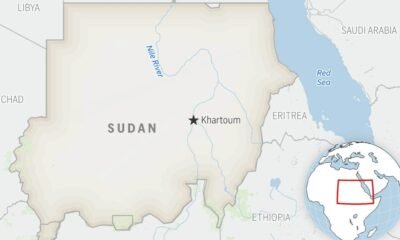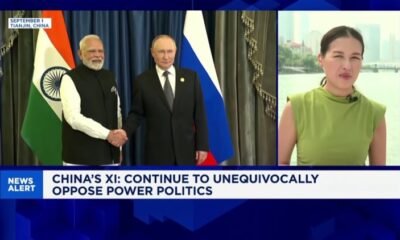Top Stories
Trump announces 25% tariff on India starting Aug. 1

WASHINGTON (AP) — President Donald Trump said Wednesday that he’ll impose a 25% tariff on goods from India, plus an additional import tax because of India’s purchasing of Russian oil.
Trump said on his Truth Social platform that India “is our friend” but its “Tariffs are far too high” on U.S. goods.
The Republican president added that India buys military equipment and oil from Russia, which he said has enabled the war in Ukraine. As a result, he intends to charge an additional “penalty” starting on Friday as part of the launch of his administration’s revised tariffs on multiple countries.
The new tariffs could put India at a disadvantage in the U.S. market relative to Vietnam, Bangladesh and, possibly, China, said Ajay Sahai, director general of the Federation of Indian Export Organisations.
“We are back to square one as Trump hasn’t spelled out what the penalties would be in addition to the tariff,” Sahai said. “The demand for Indian goods is bound to be hit.”
The announcement comes after a slew of negotiated trade frameworks with the European Union, Japan, the Philippines and Indonesia — all of which Trump said would open markets for American goods while enabling the U.S. to raise tax rates on imports. The president views tariff revenues as a way to help offset the budget deficit increases tied to his recent income tax cuts and generate more domestic factory jobs.
While Trump has effectively wielded tariffs as a cudgel to reset the terms of trade, the economic impact is uncertain as most economists expect a slowdown in U.S. growth and greater inflationary pressures as some of the costs of the taxes are passed along to domestic businesses and consumers.
Trump’s approach of putting a 15% tariff on America’s longstanding allies in the EU is also generating pushback — possibly causing European partners as well as Canada to seek alternatives to U.S. leadership on the world stage.
French President Emmanuel Macron said Wednesday in the aftermath of the trade framework that Europe “does not see itself sufficiently” as a global power, saying in a cabinet meeting that negotiations with the U.S. will continue as the agreement gets formalized.
“To be free, you have to be feared,” Macron said. “We have not been feared enough. There is a greater urgency than ever to accelerate the European agenda for sovereignty and competitiveness.”
Washington has long sought to develop a deeper partnership with New Delhi, which is seen as a bulwark against China. Indian Prime Minister Narendra Modi has established a good working relationship with Trump, and the two leaders are likely to further boost cooperation between their countries.
The Census Bureau reported that the U.S. ran a $45.8 trade imbalance in goods with India last year, meaning it imported more than it exported.
At a population exceeding 1.4 billion people, India is the world’s largest country and a possible geopolitical counterbalance to China. India and Russia have close relations, and New Delhi has not supported Western sanctions on Moscow over its war in Ukraine.
The new tariffs on India could complicate its goal of doubling bilateral trade with the U.S. to $500 billion by 2030. The two countries have had five rounds of negotiations for a bilateral trade agreement. While U.S. has been seeking greater market access and zero tariff on almost all its exports, India has expressed reservations on throwing open sectors such as agriculture and dairy, which employ a bulk of the country’s population for livelihood, Indian officials said.
When Trump in February met with Modi, the U.S. president said that India would start buying American oil and natural gas.
Trump discussed his policies on trade and tariffs with reporters accompanying him Tuesday on the flight home following a five-day visit to Scotland. He declined to comment then when asked about reports that India was bracing for a U.S. tariff rate of at least 25%, saying, “We’re going to see.”
Trump also said the outlines of a trade framework with India had not yet been finalized. Once back at the White House on Tuesday, Trump indicated that there were no plans to announce new tariff rates on Wednesday, a claim that turned out to be inaccurate.
__
Roy reported from New Delhi. Samuel Petrequin contributed to this report from Paris.
Top Stories
Stock market today: Dow, S&P 500, Nasdaq sink as Treasury yields jump amid tariff, Fed uncertainty – Yahoo Finance

- Stock market today: Dow, S&P 500, Nasdaq sink as Treasury yields jump amid tariff, Fed uncertainty Yahoo Finance
- Wall St hits over one-week low on tariff uncertainty, data in focus Reuters
- US stocks fall as bond sell-off spills into equities Financial Times
- Stock Market Today: Dow Futures Fall; Treasury Yields Rise — Live Updates The Wall Street Journal
- Dow falls 250 points to kick off September on tariff worries, rising bond yields: Live updates CNBC
Top Stories
‘Trump loses again’: California governor reacts to judge ruling that national guard in LA violated federal law – live | Trump administration

Newsom after judge ruling on national guard in LA: ‘Trump loses again’
California governor Gavin Newsom responded to his state’s federal court win that Trump’s deployment of national guard troops in Los Angeles this summer was illegal.
“DONALD TRUMP LOSES AGAIN” Newsom posted on X. “The courts agree — his militarization of our streets and use of the military against US citizens is ILLEGAL.”
Key events
Rudy Giuliani has been discharged from the hospital and is “progressing well” following a car collision in New Hampshire on Saturday, his spokesperson Ted Goodman said.
“The mayor would like to thank the New Hampshire State Police, paramedics, Elliot Hospital, and all the physicians and nurses who provided incredible care” Goodman added.
Newsom after judge ruling on national guard in LA: ‘Trump loses again’
California governor Gavin Newsom responded to his state’s federal court win that Trump’s deployment of national guard troops in Los Angeles this summer was illegal.
“DONALD TRUMP LOSES AGAIN” Newsom posted on X. “The courts agree — his militarization of our streets and use of the military against US citizens is ILLEGAL.”
Trump plans to move Space Command headquarters to Alabama from Colorado, sources tell Reuters
According to Reuters, the Trump administration is planning to announce that it will relocate the headquarters of US Space Command from Colorado Springs, Colorado, to Huntsville, Alabama, sources familiar with the deliberations told the outlet.
The decision is a reversal of the Biden administration’s choice in 2023, when Colorado Springs was selected as the permanent home for the military’s newest combatant command after an extensive review process.
Space Command currently operates from Peterson Space Force Base in Colorado Springs on an interim basis, where it has been headquartered since its reestablishment under Trump in 2019.
A live streaming link ahead of the 2pm ET Trump announcement posted by the Defense Visual Information Distribution Service (DVIDS), the US military’s official media distribution arm, describes the event as a “US Space Command HQ Announcement”.
Trump illegally deployed national guard during LA immigration protests, judge rules
A Washington judge has found that Trump illegally deployed National Guard troops during immigration enforcement operations in Los Angeles this summer.
Judge Charles Breyer ruled that sending military personnel alongside immigration agents violated the Posse Comitatus Act, which bars the armed forces from domestic law enforcement. California brought the legal challenge against the federal government.
The Trump administration argued the troops were only protecting federal officers, not conducting arrests themselves. The judge did not order the remaining military personnel to be withdrawn.
Nadler is one of the most influential House Democrats in office, and represents a high-profile Manhattan district steeped in prominent fundraising and media attention.
A member of the progressive caucus, the 78-year-old built a reputation as a reliable voice on issues like abortion rights, LGBTQ rights, and government accountability.
Unlike Democratic party leaders and New Yorkers Hakeem Jeffries and senator Chuck Schumer, Nadler endorsed Democratic mayoral nominee Zohran Mamdani ahead of the general election.
Democratic representative Jerry Nadler won’t seek re-election
New York representative Jerry Nadler officially announced that he will relinquish his seat next election after serving over three decades in Congress.
“This decision has not been easy” he wrote in the statement. “But I know in my heart it is the right one and that it is the right time to pass the torch to a new generation”.
There are murmurs that instead the “exciting announcement” will be about renaming the Department of Defense to the “Department of War” – it’s former name previously discontinued in 1947.
A number of news outlets reported ahead of Labor Day that the White House had been working up plans for the reverted name, citing a White House official.
In his latest posting on Truth Social, Trump wrote: “CHICAGO IS THE MURDER CAPITAL OF THE WORLD!”
In late August, Pentagon sources told the Washington Post and Rolling Stone that planning was actively underway for a national guard operation in Chicago, though no final decision had been announced.
When asked at the time, a Pentagon official told the Guardian “we won’t speculate on further operations” and that the department is “continuously working” with other agencies on “plans to protect federal assets and personnel”.
It’s still unclear what the announcement will touch on, but the White House rapid response team shared a Trump post from Truth Social this morning saying that “Chicago is the worst and most dangerous city in the World, by far’” and added “[governor JB] Pritzker needs help badly, he just doesn’t know it yet”.
“I will solve the crime problem fast, just like I did in DC”, he wrote.
Top Stories
Trump National Guard California Newsom

The National Guard, police and protesters stand off outside of a downtown jail in Los Angeles following two days of clashes with police during a series of immigration raids on June 08, 2025 in Los Angeles, California.
Spencer Platt | Getty Images
A federal judge on Tuesday barred President Donald Trump from deploying National Guard and other military troops in California to execute law-enforcement actions there, including making arrests, searching locations, and crowd control.
The ruling came in connection with a lawsuit filed in early June by the state of California challenging Trump’s and Defense Secretary Pete Hegseth’s deployment of the Guard to deal with protests in Los Angeles over the Trump administration’s immigration enforcement policies.
Judge Charles Breyer said that Trump’s deployment of thousands of National Guard troops and 700 Marines to L.A. violated the federal Posse Comitatus Act, which bars U.S. Military forces from enforcing the law domestically.
Breyer’s ruling in U.S. District Court in San Francisco is limited to California, and the judge stayed the decision until Sept. 12 to give the Trump administration time to appeal it.
But it comes as Trump has considered deploying National Guard troops to other U.S. cities to deal with crime, including Oakland and San Francisco.
Breyer warned that it would create “a national police force with the President as its chief.”
Gov. Gavin Newsom gloated about the ruling in a social media post.
“DONALD TRUMP LOSES AGAIN,” Newsom wrote on X.
“The courts agree — his militarization of our streets and use of the military against US citizens is ILLEGAL.”
Breyer, in his ruling,g wrote, “Congress spoke clearly in 1878 when it passed the Posse Comitatus Act, prohibiting the use of the U.S. military to execute domestic law.”
“Nearly 140 years later, Defendants — President Trump, Secretary of Defense Hegseth, and the Department of Defense — deployed the National Guard and Marines to Los Angeles, ostensibly to quell a rebellion and ensure that federal immigration law was enforced,” the judge wrote.
“There were indeed protests in Los Angeles, and some individuals engaged in violence,” Breyer wrote.
“Yet there was no rebellion, nor was civilian law enforcement unable to respond to the protests and enforce the law.”
Breyer said that evidence introduced during a trial for the lawsuit shows that the defendants had “systematically used armed soldiers (whose identity was often obscured by protective armor) and military vehicles to set up protective perimeters and traffic blockades, engage in crowd control, and otherwise demonstrate a military presence in and around Los Angeles.”
CNBC has requested comment on the ruling from the Justice Department, which represented the Trump administration in the lawsuit.
This is breaking news. Please refresh for updates.
-

 Business4 days ago
Business4 days agoThe Guardian view on Trump and the Fed: independence is no substitute for accountability | Editorial
-
Tools & Platforms3 weeks ago
Building Trust in Military AI Starts with Opening the Black Box – War on the Rocks
-

 Ethics & Policy1 month ago
Ethics & Policy1 month agoSDAIA Supports Saudi Arabia’s Leadership in Shaping Global AI Ethics, Policy, and Research – وكالة الأنباء السعودية
-

 Events & Conferences3 months ago
Events & Conferences3 months agoJourney to 1000 models: Scaling Instagram’s recommendation system
-

 Jobs & Careers2 months ago
Jobs & Careers2 months agoMumbai-based Perplexity Alternative Has 60k+ Users Without Funding
-

 Education2 months ago
Education2 months agoVEX Robotics launches AI-powered classroom robotics system
-

 Funding & Business2 months ago
Funding & Business2 months agoKayak and Expedia race to build AI travel agents that turn social posts into itineraries
-

 Podcasts & Talks2 months ago
Podcasts & Talks2 months agoHappy 4th of July! 🎆 Made with Veo 3 in Gemini
-

 Education2 months ago
Education2 months agoAERDF highlights the latest PreK-12 discoveries and inventions
-

 Education2 months ago
Education2 months agoMacron says UK and France have duty to tackle illegal migration ‘with humanity, solidarity and firmness’ – UK politics live | Politics





















